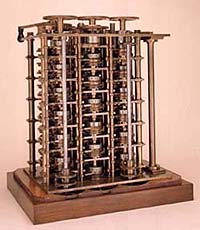 History: calculators and computers
History: calculators and computers
Later in the 17th century, calculators which could mutiply were invented by Leibniz (1671) in Germany, and Morland (1673) in England. However, it was not until the 19th century that Charles Babbage (1792 – 1871) designed a new calculator – the Babbage difference engine – to calculate mathematical tables. It was fully built only a few years ago in London (where it is on display), but Babbage’s design included features of the modern computer: a memory, and the capacity to be programmed for a variety of functions. Computers were not realized in a practical way until the mid-1940s. The modern calculator evolved from the work of Thomas de Colmar in 1820. First mechanical and electro-mechanical forms were built; later the invention of silicon chip technology together with logic circuitry based on Boolean algebra gave rise to the modern electronic calculator.
The electronic calculator


 History: calculators and computers
History: calculators and computers